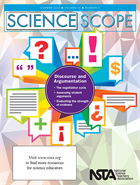Discourse and argumentation
By Mary Bigelow
Posted on 2013-07-07
 “Engaging in argument from evidence” is one of eight practices described in A Framework for K-12 Science Education and the NGSS. Teachers may be wondering what this might look like in a middle school classroom, where students seem to have a lot of experience in arguing over events in their social lives but not much in argumentation in science.
“Engaging in argument from evidence” is one of eight practices described in A Framework for K-12 Science Education and the NGSS. Teachers may be wondering what this might look like in a middle school classroom, where students seem to have a lot of experience in arguing over events in their social lives but not much in argumentation in science.
If you’re new to this type of activity in class, see how the editor of Science Scope (in the Editor’s Roundtable) describes her experiences in implementing argumentation. She suggests learning more about the practice, being patient and persistent with students (and yourself), helping and encouraging all students (not just the more vocal ones) to participate, providing frequent opportunities and modeling, and establishing a positive environment for students to learn. The featured articles address these with examples of real classroom activities as well as in-depth discussions of the process of argumentation.
Many of us provide opportunities for students to learn the difference between observations, opinions, and inferences. The article Helping Students Evaluate the Strength of Evidence in Scientific Arguments describes how to use the concept of inferential distance to examine the strength of an argument. The authors define this as the “size of the conceptual leap made in going from evidence to conclusion.” They use an example of an afterschool project in which students studied pond ecosystems to illustrate three types of inferential distances, and they include some instructional activities to teach about inferences. [See SciLinks for more on science content related to Aquatic Plants and Animals, Aquatic Ecosystems, Lakes and Ponds]
If you’re concerned about how to connect argumentation with the development of core ideas, A Negotiation Cycle to Promote Argumentation in Science Classrooms has some suggestions. The authors describe six phases of the cycle: identifying a research question, small group investigation, presenting group arguments, comparing arguments with published information, presenting revised arguments, and individual reflection. Using the human respiratory system as the content, the article describes and illustrates each phase with handouts and examples of student work. Guidelines and a rubric are included. [See SciLinks for more on science content related to the Respiratory System]
Assessing Students’ Arguments has tools for teachers and students to use to assess the strength of student arguments. The checklist is student-friendly and includes places to annotate the presence (or absence) of a claim, the appropriateness of the justifications, and the type of rebuttal. The authors include examples of what the use of the checklist looks like in a class in which students read about the construction of a dam in a remote part of the Amazon basin. They also provide examples of student work and a brief look at how the process was applied to an investigation of density. [See SciLinks for more on science content related to the Rainforest and Density]
Growing plants from seeds is a common activity in science classrooms. Let’s Talk Science shows how to kick this up a notch and incorporate argumentation about cells and plant growth. Three activities are described that focus on the question “Are seeds alive?” The author also provides a rubric, activity sheets with directions, and samples of student work. For assistance in modeling the process of argumentation, the author also includes some scenarios for role-playing and a list of prompts to scaffold the process. [See SciLinks for more on science content related to Seed Germination, Plant Growth]
The authors of Turning the Science Classroom Into a Courtroom describe a courtroom metaphor to help students understand argumentation. Most students are familiar with courtrooms through popular television programs, so this seems to be a good way to scaffold their understanding. The next step might be to “debate” topics that are more complex or controversial or about which students have misconceptions. A sample list of topics is provided, and they illustrate how scientific argumentation aligns with literacy standards in reading, writing, speaking, and listening.
In many classrooms, discussions consist of the teacher asking questions and providing the structures for student interactions. The authors of The Practice of Critical Discourse in Science Classrooms differentiate between higher levels of communication, including conversation (“the dynamic exchange of ideas and reflection”), critical discourse (“accentuating connections between ideas and evidence”), and argumentation (“use of evidence to process and learn about ideas)”). The authors use a demonstration of the sublimation of dry ice in beakers of hot and cold water to illustrate what this could look like in a classroom. They then describe six elements to foster this level of thinking and communicating. The article also has suggestions for applying argumentation in a class in which the students have a diversity of background experiences. Students learn that science is not merely a set of established facts, but a process involving critical thinking and processing new ideas.
Show Me the Evidence describes several strategies that can be use to support teachers as they incorporate more evidence-based discourse in the classroom: analyzing the teacher-student and student-student conversations in video clips, role-playing, peer coaching, the use of wait time, and fostering a “safe” environment in the classroom for argumentation.
Disclaimer: The views expressed in this blog post are those of the author(s) and do not necessarily reflect the official position of the National Science Teaching Association (NSTA).


